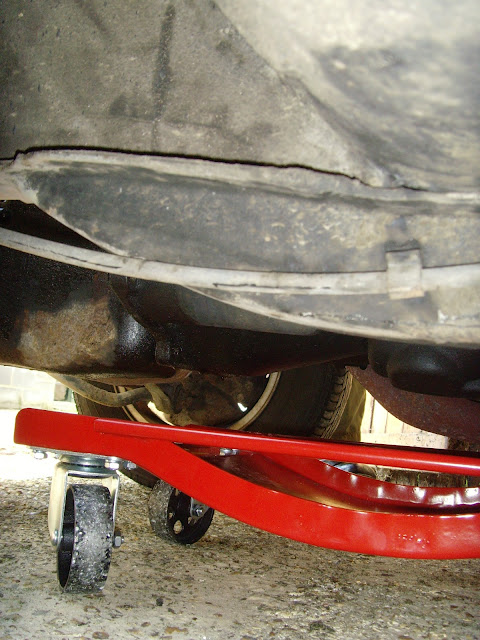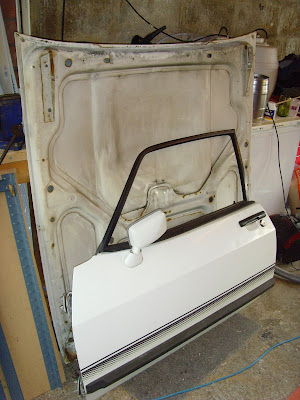How to remove your Ford Capri engine
(OHV Pinto 4 cyl)
 |
| "And you say it won't start, eh?" |
Removing the engine isn't actually all that hard, im pretty certain now that as a child I was dropped from some height, onto a substantially hard floor...
... and even I could do it!
Its very methodical, but its easy if you work methodically, and don't go bat***t crazy like I normally do... anyway! Without further ado!
Tools
- A decent socket set, deep set preferably, as some bolts are recessed.
- A decent spanner set!
- An Irish screwdriver. Failing that, a chuffing great big mallet.
- Wire snips.
- Tape.
- A marker pen.
- He-man abilities, or a jack.
- Jack stands.
- A trolly, or anything along those lines to support the gearbox!
- Pliers
- Screwdriver set
- Engine crane/ hoist
- A friend :)
- Enough tea to sink a ship.
Remove the battery.
The bonnet needs to come off to allow the crane in, so thats the first thing to go, its not all that hard, and with a friend comes off pretty easy!
First locate the bolts that hold the bonnet onto the bracket, and mark them off, there is a small amount of adjustment that can be made on this bracket, and chances are the person that put the bonnet on is less of an invalid than you, so you want to put it on as those zany Germans did all those years ago...
Once the bonnet is off, place it somewhere safe like on an off-cut of carpet.
Best thing to do now is work logically, start stripping the engine of its connections and various. I started with the electrics, as the pinto engine is basically a four wire connection! - alternator, two to distributer and one earth wire.
Next step, coolant system,
Its best to remove the radiator from the car because its so fragile that if you bump it when removing the engine, chances are it will be toast. Its not too hard, undo the jubilee clip on the bottom hose and pull hard. This will be followed by a stratifying "sploof" noise followed by an arm-full of rusty old manky coolant. Place a tub underneath the car if you have any mild interest in not ruining your garage, and aim to get about 3 or 4% of the coolant content in the bucket. Any more than this and you are on to a winner because IT GOES EVERYWHERE.
Of course you may have a drain plug on your radiator! use this if you do!
Fuel pipes are the next to come off, this is an easy unclip of the pipe to the mechanical fuel pump on the side of the engine.
A WORD TO THE WISE!
Top the tank up before you started restoration did you? You tit.
With a full tank or the car tilted forwards fuel runs out the pipe naturally which runs along the chassis rail. Luckily with every day driving I keep about 3 or 4 litres in the tank, so it didn't **** out everywhere, but did dribble out, and with the going rate of unleaded rivalling single malt whiskey a bolt shoved down the pipe as a plug worked a treat. A professional would drain the tank and keep the fuel in a correct container.
Im not a professional.
Everything that is not coming out now has to be disconnected, we have already done coolant pipes, fuel pipes and electrical wiring, so now its time for cables, bolts and shafts.
If you start at the top of the engine and work down you are much less likely to miss anything, and try removing the engine with some bolts still attached...I would never have dreamt of doing this...

Exhaust manifold, this does need to be removed, but whether or not you want to take off the intake manifold is entirely up to you. I didn't because I am lazy and its a pointless thing to do as I am stripping the engine down on a bench anyway.
You can see at the bottom of the above picture the exhaust is disconnected and moved away from the block, there should be just enough give in the pipe to move it away without taking the header off the exhaust pipe as there was in mine. However I have a performance 4-1 exhaust, the original part may not give such a luxury! Make a note of the bolts and keep them safe.
With the car jacked up crawl underneath and remove the stater motor, its only three bolts and the electrical connections.
The sump and oil pressure sender pipe can also be seen. Top left centre of the picture.*
Boom! Out she comes!
Next remove the oil pressure sender pipe. And the electrical connection next to it. These can be seen in the picture that I put a * by.
ASSEMBLE THE HOIST! Exciting times people. Exciting times.
Doing that was harder than anything previously mentioned in this blog. Jesus mother. Its a 'slot A into flange B' affair. An innuendo on wheels.
If the car isn't on jack stands anymore it makes the removal slightly easier as the crane doesn't have to reach as high.
Strap the engine up to the crane with a suitable means, I used a tow rope and shackles. Old seat-belts are suitable, just don't use regular rope, thin chain, spaghetti..
Take the weight just ever so slightly from the engine, so you know it won't all slump onto the gearbox when you remove the engine mounts...
Next step! Remove the gearbox bolts. Go around the bell housing and remove every single one. Yes even that little one. Which I didn't and then wondered why the engine wouldn't come out...
Chop up some blocks and place a trolly underneath the gearbox to support it. The engine holds alot of the gearbox weight, so this is a very necessary step unless you want to do horrible things to your propshaft!
After this its the engine mounting bolts!
These can be seen in the above picture. I found it easier to unbolt the bracket as this means the engine can lift vertically up rather than having to worm it through odd angles.
After this pull the engine forwards towards you to pull it off the gearbox splines...the engine should now be free to winch up!
Easy ay!
Rest the engine somewhere sensible, it still weighs 150kg! An old pallet is a good idea, but don't drop it on its sump as this will smash if not careful!
Well done! you have done it! Now if you have the time/ effort and haven't suffered major blood loss, a quick inspection of the engine and bay will let you know what kind of condition you pride and joy is/ was in!
Turns out mine leaked like a new born puppy!
Oil leaked from the bottom end gasket into the gearbox bell housing...
Leaked from the rocker cover....
The sump...
But worst of all...
Into the cylinders.
Its not really a problem, but it does show a potential flaw I had with the car which was dieseling (engine run on) with the engine switched off. Read about it more with this appropriately titled topic. AHHHGGH CRAP MY ENGINE WON'T SWITCH OFF.
I am supposing that a carbon build up was the cause of mine, and this is easy to see through the exhaust ports.
 |
| Cylinder One |
 |
| Cylinder Two |
 |
| Cylinder Three |
 |
| Cylinder Four |
Its obvious that cylinder two and three are burning oil, which is probably due to nackered valve guides. Which control the oil from the head down the valve stem. But the fact that the two cylinders are next to each other worries me...
Every cylinder is carbon..ed up due to 140k miles and no love. So a good strip down and clean will probably do wonders on its own!
Anyway! The engine strip down is for another time! Next blog is how to replace a panel part. A crash course.
















































